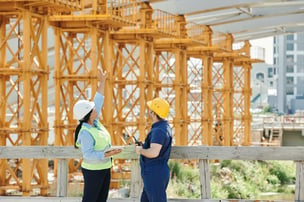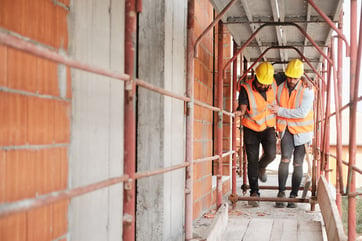It goes without saying that safety must always take top priority in the workplace.
While on the clock, workers rely on their employers to set standards and provide all necessary equipment to protect them from potential accidents.
This is acutely important in the construction sector where exposure to serious hazards–particularly falls to lower levels–are commonplace.
Because of this, the first week of May is annually deemed National Safety Stand Down Week: a time for employers to focus on training and awareness surrounding the far too frequent occurrence of jobsite falls.
While businesses have a responsibility to keep workplace safety top of mind year-round, National Safety Stand Down week offers the opportunity to specifically address these topics and to arm employees with knowledge that can help to keep them safe.
In this article we'll explore:
- what a safety stand down is
- more of the details surrounding National Safety Stand Down week
- why construction workers need safety stand down training
- how to successfully conduct a safety stand down
- tips on preventing falls on construction sites
What Is a Safety Stand Down?
The Occupational Safety and Health Administration (OSHA) defines a safety stand down as, “a voluntary event for employers to talk directly to employees about safety.”
In other words, it is an effort which invites businesses to evaluate their existing safety practices and to educate their employees on the prevention of workplace-related injuries.
What is National Safety Stand Down Week?
 Since 2012, OSHA has partnered with occupational safety organizations including the National Institute for Occupational Safety and Health (NIOSH) and the National Occupational Research Administration (NORA) to increase awareness about workplace safety with a specific focus on the prevention of fatal falls in the construction sector.
Since 2012, OSHA has partnered with occupational safety organizations including the National Institute for Occupational Safety and Health (NIOSH) and the National Occupational Research Administration (NORA) to increase awareness about workplace safety with a specific focus on the prevention of fatal falls in the construction sector.
The nation-wide event will take place from May 2 until May 6, 2022. Businesses are encouraged to participate in regional planned events, or to host events of their own.
Why Is Fall Prevention Awareness Important in Construction?
While workplace safety is a top priority across all industries, the construction sector is one of the most significantly affected.
Construction professionals frequently work from elevated platforms such as roofs, scaffolds, and ladders: This makes those in construction fields more vulnerable to fall-related casualties.
According to the CDC, “Falls are the number one cause of construction-worker fatalities, accounting for one-third of all on-the-job deaths in the industry.”
Falls to a lower level are the leading cause of death in the construction sector, and it’s estimated that they constitute 36.5% of all workplace deaths.
With these statistics in mind, it is without question that fall prevention for construction workers is a crucial topic for risk management and safety education.
How Do I Conduct a Safety Stand Down?
1. Decide Who Should Attend
Any employees who are regularly working on jobsites should certainly be in attendance, but you may also consider inviting other employees within your organization such as project managers. Estimators, who are responsible for identifying costs associated with fall protection equipment, may also benefit from safety stand down training programs.
OSHA also suggests including outside parties affiliated with construction projects, including architects, engineers, and subcontractors. This is a good opportunity for companies to show their commitment to workplace safety and to forge stronger relationships with their industry partners.
2. Prepare Your Materials
Start off by deciding how you want to conduct your stand down: Some may prefer to conduct a number of short topical discussions referred to as toolbox talks throughout the week while others may prefer to block off an extended period of time dedicated to intensive training.
Regardless of the time you choose to allocate toward the stand down, it is always a good idea to incorporate some interactive material that allows your employees to engage in the presentation. Hands-on activities help to maintain your audience’s focus and allow for greater retention of information.
OSHA’s official campaign website is a great resource to get you started with resource material and interactive activities.
3. Conduct the Stand Down
While conducting your stand down presentation, be sure to keep employees engaged and interested.
As previously mentioned, a good tactic for encouraging active listening and participation is to schedule some interactive exercises. A great example of this is to have employees participate in fall protection equipment inspections and demonstrations.
4. Follow Up
National Safety Stand Down week is a great way to initiate a conversation surrounding workplace safety, but these discussions should continue year-round.
Following up on the topics discussed during your stand down with regular check-ins will help to ensure these topics stay fresh in your employees’ minds.

You should also prompt attendees to provide feedback–their input on program efficacy can help to shape and improve stand down material for future years.
Lastly, be sure to track your workplace accident statistics to measure year-over-year improvements. The ultimate goal of safety stand downs is to decrease the number of workplace accidents, so improvements in these numbers can shed light on what’s working and what isn’t when it comes to your presentation materials.
How to Prevent Falls in Construction?
OSHA recommends a three-part approach for reducing fall hazards in the construction sector:
- Plan: Employee safety should be prioritized even before a job begins by ensuring that project bids account for costs associated with fall protection equipment.
- Provide: OSHA requires fall protection equipment for anyone performing work “6 ft or more above lower levels.” Obtain and guarantee access to all necessary gear for any employees who fall into this category.
- Train: Give employees the necessary training and education to understand how they can protect themselves from falls on a jobsite. National Safety Stand Down week offers businesses the opportunity to do exactly this. By participating, you can provide your workforce with critical safety training that can help to prevent workplace falls.
In Conclusion
Here at FrankCrum, our team of experts have the knowledge and experience to guide businesses in the construction sector through all of their safety and risk management concerns. Contact us today to learn more about how FrankCrum offers HR help to the construction sector.




